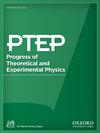A self-regulated stochastic acceleration model of pulsar wind nebulae
IF 8.3
4区 物理与天体物理
Q1 Physics and Astronomy
引用次数: 0
Abstract
Pulsar wind nebulae (PWNe) are clouds of the magnetized relativistic electron/positron plasma supplied from the central pulsar. However, the number of radio-emitting particles inside a PWN is larger than the expectation from the study of pulsar magnetospheres and then their origin is still unclear. A stochastic acceleration of externally injected particles by a turbulence inside the PWN is proposed by our previous studies. In this paper, the previous stochastic acceleration model of the PWN broadband spectra is improved by taking into account the time evolution of the turbulent energy and then the total energy balance inside a PWN is maintained. The turbulent energy supplied from the central pulsar is wasted by the backreaction from the stochastic particle acceleration and the adiabatic cooling according the PWN expansion. The model is applied to the Crab Nebula and reproduce the current broadband emission spectrum, especially the flat radio spectrum although time evolution of the turbulent energy (diffusion coefficient) is a bit complicated compared with our previous studies, where we assumed an exponential behavior of the diffusion coefficient.脉冲星风星云的自调节随机加速模型
脉冲星风星云(PWNe)是由中心脉冲星提供的磁化相对论电子/正电子等离子体组成的云。然而,脉冲星风星云内的射电发射粒子数量大于脉冲星磁层研究的预期,因此其起源仍不清楚。我们之前的研究提出了外部注入的粒子在脉动网内部湍流的随机加速。在本文中,通过考虑湍流能量的时间演化,改进了之前的 PWN 宽带谱随机加速模型,从而保持了 PWN 内部的总能量平衡。中心脉冲星提供的湍流能量被随机粒子加速的反作用力和 PWN 膨胀的绝热冷却所浪费。该模型被应用于蟹状星云,并再现了当前的宽带发射光谱,特别是平坦的射电频谱,尽管与我们以前的研究相比,湍流能量(扩散系数)的时间演化有点复杂,我们以前的研究假设扩散系数为指数行为。
本文章由计算机程序翻译,如有差异,请以英文原文为准。
求助全文
约1分钟内获得全文
求助全文
来源期刊

Progress of Theoretical and Experimental Physics
PHYSICS, MULTIDISCIPLINARY-PHYSICS, PARTICLES & FIELDS
CiteScore
12.00
自引率
5.70%
发文量
148
审稿时长
17 weeks
期刊介绍:
Progress of Theoretical and Experimental Physics (PTEP) is an international journal that publishes articles on theoretical and experimental physics. PTEP is a fully open access, online-only journal published by the Physical Society of Japan.
PTEP is the successor to Progress of Theoretical Physics (PTP), which terminated in December 2012 and merged into PTEP in January 2013.
PTP was founded in 1946 by Hideki Yukawa, the first Japanese Nobel Laureate. PTEP, the successor journal to PTP, has a broader scope than that of PTP covering both theoretical and experimental physics.
PTEP mainly covers areas including particles and fields, nuclear physics, astrophysics and cosmology, beam physics and instrumentation, and general and mathematical physics.
 求助内容:
求助内容: 应助结果提醒方式:
应助结果提醒方式:


